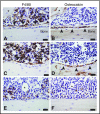Continuous blockade of CXCR4 results in dramatic mobilization and expansion of hematopoietic stem and progenitor cells
- PMID: 28400375
- PMCID: PMC5445573
- DOI: 10.1182/blood-2016-10-746909
Continuous blockade of CXCR4 results in dramatic mobilization and expansion of hematopoietic stem and progenitor cells
Abstract
Interaction between the chemokine receptor CXCR4 and its chief ligand CXCL12 plays a critical role in the retention and migration of hematopoietic stem and progenitor cells (HSPCs) in the bone marrow (BM) microenvironment. In this study, qualitative and quantitative effects of long-term pharmacologic inhibition of the CXCR4/CXCL12 axis on the HSPC compartment were investigated by using 3 structurally unrelated small molecule CXCR4 antagonists. A >10-fold increase in mobilization efficiency was achieved by administering the antagonists as a subcutaneous continuous infusion for 2 weeks compared to a single bolus injection. A concurrent increase in self-renewing proliferation leading to a twofold to fourfold expansion of the HSPC pool in the BM was observed. The expanded BM showed a distinct repopulating advantage when tested in serial competitive transplantation experiments. Furthermore, major changes within the HSPC niche associated with previously described HSPC expansion strategies were not detected in bones treated with a CXCR4 antagonist infusion. Our data suggest that prolonged but reversible pharmacologic blockade of the CXCR4/CXCL12 axis represents an approach that releases HSPC with efficiency superior to any other known mobilization strategy and may also serve as an effective method to expand the BM HSPC pool.
© 2017 by The American Society of Hematology.
Figures







Similar articles
-
Downregulation of CXCL12 signaling and altered hematopoietic stem and progenitor cell trafficking in a murine model of acute Anaplasma phagocytophilum infection.Innate Immun. 2012 Jun;18(3):418-28. doi: 10.1177/1753425911413794. Epub 2011 Sep 29. Innate Immun. 2012. PMID: 21964802 Free PMC article.
-
CXCR4 expression in the bone marrow microenvironment is required for hematopoietic stem and progenitor cell maintenance and early hematopoietic regeneration after myeloablation.Stem Cells. 2020 Jul;38(7):849-859. doi: 10.1002/stem.3174. Epub 2020 Mar 19. Stem Cells. 2020. PMID: 32159901 Free PMC article.
-
Evidence for the involvement of sphingosine-1-phosphate in the homing and engraftment of hematopoietic stem cells to bone marrow.Oncotarget. 2015 Aug 7;6(22):18819-28. doi: 10.18632/oncotarget.4710. Oncotarget. 2015. PMID: 26299919 Free PMC article.
-
Innate immunity derived factors as external modulators of the CXCL12-CXCR4 axis and their role in stem cell homing and mobilization.Theranostics. 2013;3(1):3-10. doi: 10.7150/thno.4621. Epub 2013 Jan 12. Theranostics. 2013. PMID: 23382780 Free PMC article. Review.
-
Can inhibition of the SDF-1/CXCR4 axis eradicate acute leukemia?Semin Cancer Biol. 2010 Jun;20(3):178-85. doi: 10.1016/j.semcancer.2010.07.001. Epub 2010 Jul 15. Semin Cancer Biol. 2010. PMID: 20637871 Review.
Cited by
-
Targeting VLA4 integrin and CXCR2 mobilizes serially repopulating hematopoietic stem cells.J Clin Invest. 2019 May 14;129(7):2745-2759. doi: 10.1172/JCI124738. J Clin Invest. 2019. PMID: 31085833 Free PMC article.
-
Stable colony-stimulating factor 1 fusion protein treatment increases hematopoietic stem cell pool and enhances their mobilisation in mice.J Hematol Oncol. 2021 Jan 6;14(1):3. doi: 10.1186/s13045-020-00997-w. J Hematol Oncol. 2021. PMID: 33402221 Free PMC article.
-
Small-molecule CBP/p300 histone acetyltransferase inhibition mobilizes leukocytes from the bone marrow via the endocrine stress response.Immunity. 2024 Feb 13;57(2):364-378.e9. doi: 10.1016/j.immuni.2024.01.005. Epub 2024 Jan 31. Immunity. 2024. PMID: 38301651 Free PMC article.
-
C-X-C motif chemokine receptor 4-directed PET signal in the arterial tree is not consistently linked to calcified plaque burden and cardiovascular risk.Theranostics. 2025 Jan 1;15(3):804-814. doi: 10.7150/thno.102910. eCollection 2025. Theranostics. 2025. PMID: 39776816 Free PMC article.
-
Glucocorticoid guides mobilization of bone marrow stem/progenitor cells via FPR and CXCR4 coupling.Stem Cell Res Ther. 2021 Jan 7;12(1):16. doi: 10.1186/s13287-020-02071-1. Stem Cell Res Ther. 2021. PMID: 33413641 Free PMC article.
References
-
- Spangrude GJ, Heimfeld S, Weissman IL. Purification and characterization of mouse hematopoietic stem cells. Science. 1988;241(4861):58-62. - PubMed
-
- To LB, Levesque JP, Herbert KE. How I treat patients who mobilize hematopoietic stem cells poorly. Blood. 2011;118(17):4530-4540. - PubMed
-
- Karpova D, Bonig H. Concise review: CXCR4/CXCL12 signaling in immature hematopoiesis–lessons from pharmacological and genetic models. Stem Cells. 2015;33(8):2391-2399. - PubMed
Publication types
MeSH terms
Substances
Grants and funding
LinkOut - more resources
Full Text Sources
Other Literature Sources
Medical
Molecular Biology Databases

